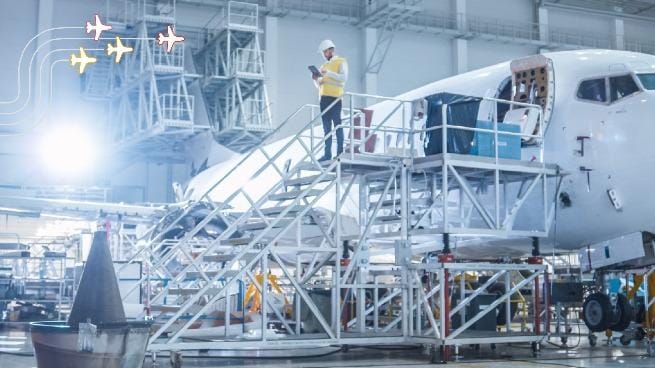

Global aerospace and defense: Annual performance and outlook
PwC's annual review and analysis of aerospace and defense industry performance in the past year, and the challenges and opportunities in the years ahead.
Our 2024 report series provides an extensive analysis of two complementary data sets, AIA’s survey of membership organizations and the results from our survey of 2000 labor market participants. AIA’s data evaluates the year-over-year employer trends related to turnover and attrition, hiring strategies, upskilling, and representation, while our survey draws insights from labor market participants in a variety of industries across all 50 states, all of whom have varying tenures, generations, gender identities, roles, exemption status, and responsibilities.
What we’ve found is that broader labor market perceptions of the industry are strong. In other words, attraction isn’t necessarily an outsized problem within A&D. The challenge that A&D organizations seemingly continue to face is in creating sticky experiences that drive retention once an employee has accepted an offer.

Data from our AIA employer survey and the labor market study highlighted five key labor trends that should be considered when evaluating broader corporate and organizational strategy:
Labor market perceptions of the aerospace and defense industry are strong.
Ineffective workforce planning practices have generated unsustainable tenure distributions within organizations as emerging retirements and turnover plague the industry.
Employees within the industry do not feel empowered to drive change because they don’t believe they have the right tools, processes, and ways of working to drive progress.
Employee onboarding, development experiences, and skill gaps continue to drive engagement challenges and contribute to higher-than-average quit rates, especially within the touch-labor population.
A divergence in experience between salaried and hourly workers is at the heart of a cultural divide within organizations.
A&D firms need to address pressures across cost, capacity, capability and compliance. A company’s workforce plays a significant role in each of these factors.
Throughout our series of thought leadership pieces, we will share some perspectives on addressing the gap between strong labor market perceptions of the industry and ongoing challenges related to attraction and retention of key talent. Specifically, we’ll share some points of view on:

Empowering employees to improve the way work gets done
Leveraging workforce planning and knowledge management tactics to future-proof your organization
Evolving the organizational employee value proposition to address the gap between exempt and non-exempt workers
Reimagining the employee development experience
The A&D industry’s highly regulated nature can sometimes generate significant barriers to agility in delivering products and services. Government regulations, security measures, and complex global supply chains frequently disrupt business processes. For example, the cost to drive compliance with government regulations continues to increase every year, with the federal regulatory burden now costing small manufacturers at least $50,000 per employee per year1. These constraints, coupled with rigid customer operating procedures and legacy tools and technologies, can often hinder innovation and limit the empowerment of employees to drive change in process and ways of working.
1. “Regulatory Onslaught Costing Small Manufacturers More Than $50,000 Per Employee.” Press Release, 25 Oct. 2023.

The past few years have been transformative for the labor market, with shifting employee desires, evolving employer expectations, and a change in working population demographics, as an estimated 30% of the U.S. civilian workforce is now part of Generation Z.
Recognizing the need for stronger upskilling programs for new hires and seasoned staff alike, organizations continue to invest in employee development and skills. However, our study of the market indicates that this investment is not materializing into improved employee engagement.
Our labor market analysis indicates two compelling points: (1) A&D employees were the least likely to believe that their organizations provide learning opportunities and career advancement when compared to other industries, and (2) labor market participants perceived the A&D industry to be among the least attractive sectors for career growth, learning, and advancement opportunities.
Ongoing prioritization of real-time development is crucial to drive enhanced engagement and minimize attrition, especially for mission-critical roles within engineering and manufacturing.

Organizations in the A&D industry are curating their hiring and retention tactics based on job profiles, but there is a divergence in perception and experience between touch labor and salaried back-office staff. Customizing the employee value proposition (EVP) is crucial to address this and drive retention while cutting costs.
In order to properly address these issues, A&D organizations need to understand the growing divergence between exempt and nonexempt employees, how to use data to create an EVP, and the interconnectedness of employee well-being and a successful EVP.

By leveraging employee preference analytics to curate the employee value proposition, organizations can address the divergence between touch labor and salaried staff, drive retention, and achieve cost savings, while also improving offerings and creating a more inclusive workplace experience. This approach can help address challenges related to attracting and retaining critical talent.
In the A&D industry, efficient workforce planning has become crucial to meet existing program demands and address customer growth priorities. The data from our 2024 On the Horizon series reveals that the A&D workforce is reaching an inflection point in terms of tenure, age, and employee breakdown. Without proactive workforce planning, organizations face challenges in attracting and replacing retiring or departing employees.
The age distribution within A&D organizations is concerning, with only 7% of employees under 25 years old and 25% aged 56 or older. Additionally, the tenure trend shows that a significant portion of the workforce (43.3%) has been with their current company for less than five years, indicating a potential loss of experienced talent. Furthermore, the A&D industry is lagging behind other sectors in terms of demographic representation, including gender breakdown, Black/African American, and Hispanic/Latino employees. This misalignment with the US working population presents an opportunity to enhance diversity and inclusion within the A&D labor population.

Recognizing the need for a workforce strategy, organizations are placing emphasis on developing a comprehensive workforce plan and investing in upskilling and reskilling employees to meet evolving work and technology requirements. By prioritizing these initiatives, companies can attract and retain the right talent with the necessary skills, increasing productivity and ensuring long-term success. Critical aspects of effective workforce planning includes anchoring efforts on skills and competencies that can be informed by data, rather than backward-looking roles.
To effectively prioritize workforce planning, organizations must adopt a cyclical approach embedded in ongoing business planning processes. This model requires continual monitoring of progress to help keep the action plan on target with the business strategy and can incorporate DEI into existing planning processes to address key representation gaps. This will enable a firm desire to expand diversity across all aspects to prepare for a younger, more diverse workforce. The six steps include:


PwC's annual review and analysis of aerospace and defense industry performance in the past year, and the challenges and opportunities in the years ahead.


What are the workforce challenges facing the A&D industry? And how firms can adapt their talent practices to solve their customers’ and workers’ evolving needs.


PwC helps clients in the aerospace and defense (A&D) industry address key business issues, comply with government regulation and manage supply chain risks.


PwC helps clients in the space sector drive business reinvention scale, confront supply-chain challenges and pilot the transformation to a more sustainable world.